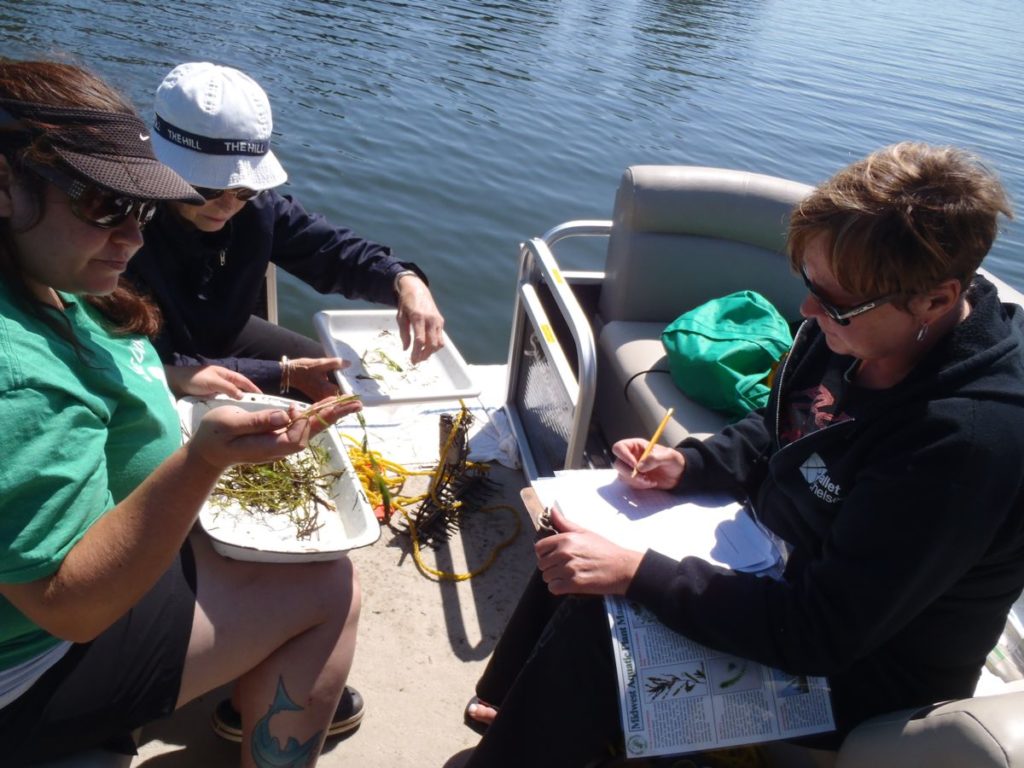It’s going to be a great year for the CLMP’s Exotic Aquatic Plant Watch! The Exotic Aquatic Plant Watch (EAPW) is a component of the Cooperative Lakes Monitoring Program (CLMP) where volunteers sample, identify, and map aquatic invasive plants in their lake. The EAPW is vital to the effort to locate and minimize the detrimental effects caused by aquatic invasive species. If you are unfamiliar with the EAPW or want more information, you can find more details on the CLMP web page.
There are several great bits of news coming out of the EAPW so far this year:
1) A brand new comprehensive EAPW video will be released in March.
2) EAPW enrolled completion rate, based on 2015 results, has almost doubled since the EAPW became a permanent part of the CLMP in 2011.
3) In 2016, EAPW staff will continue to visit volunteers on participating lakes, improve teamwork resources, and develop guidance for volunteers that find invasive aquatic plants in their lake.

First, let’s talk about the new video. If you have been on the CLMP training page (https://micorps.net/lake-monitoring/lake-training/) you know that we have a variety of short, informational videos that demonstrate how to complete some of the CLMP water quality parameters. In March, we will add a 15-minute EAPW training video. This video demonstrates how to identify the four species on the EAPW watch list, how to sample your lake for these species, and how to map your work, and highlights the importance of citizen monitors in protecting Michigan’s lakes. Whether you are looking for details on how to conduct a survey or a refresher course in plant identification, this video is for you! We are very proud of this new addition to the training library on our web page and we hope you will take some time to watch and learn.
Second, for the last several years, CLMP staff have been implementing strategies to increase volunteer enrollment and reporting of data in the EAPW. While many volunteers were attending the annual training events, we were noticing relatively low enrollment in the EAPW, and even more concerning, the numbers of reports received by staff was drastically lower compared to the number of lakes enrolled. After several years of researching how to improve these numbers, and implementing actions to address these issues, we are glad to say that both enrollment and reporting have improved in the EAPW. In 2015, 32 lakes enrolled, and a total of 77 lakes have participated since the program’s inception in 2007. Even better, the percentage of enrolled lakes completing their surveys has improved from 43% in 2011 to 79% in 2015. This is excellent news for the EAPW! This means that our volunteers, the CLMP program, and the State of Michigan know that much more information about the presence (or even better, the absence!) of invasive aquatic plants in Michigan lakes. These results are so noteworthy that CLMP staff shared our success at the Midwest Fish and Wildlife Conference in Grand Rapids in January. The conference audience included natural resource agency staff, researchers, educators, and other interested people from Michigan and other Midwestern states. This success would not be possible without all of the volunteers that have contributed their time and energy to the EAPW.

Finally, in 2016 we will continue our efforts to advance the program through our dedication to improving and enhancing the volunteer experience. We will continue offering and conducting interactive side-by-side visits and trainings and will continue to request your feedback on our teamwork training and teamwork training tips worksheet that is now a part of the CLMP annual training agenda. Teamwork training was incorporated into last year’s EAPW training at Boyne Mountain and throughout the year to EAPW participating lakes. We would love to hear from any volunteers who have benefited from this particular addition to the EAPW resources. If you have any advice or comments to the staff about your experiences working in teams to complete EAPW surveys or even CLMP parameters, please let us know.
We are currently working on helpful guiding resources for volunteers who find a new invasive species in their lakes – what do you do next? Several volunteers have requested this guidance since the CLMP is focused on monitoring, and not management, of invasive species. There are many management options available, depending on the invasive species you are dealing with.
For an interesting case study of one lake’s response to discovering starry stonewort in their lake while conducting an EAPW survey, visit: http://msue.anr.msu.edu/news/micorp_training_aids_in_early_detection_of_invasive_species.
If you have advice or suggestions from your experience working towards management or eradication of aquatic invasive species in your lake, please share your story with us. This program relies heavily on the feedback from others, because you could hold the key to helping others in their battle to fight exotic plants in their lake. As Charles Dickens wrote from Doctor Marigold, “No one is useless in this world who lightens the burden of it to anyone else.”
We look forward to another productive year of the EAPW and our shared efforts to find invasive species early while management is still possible. We hope you will join us in 2016!
Posted By: Angela De Palma-Dow, Exotic Aquatic Plant Watch, Michigan State University
Interested in becoming a volunteer lake monitor in 2016? It’s not too late! Enroll in the 2016 Exotic Aquatic Plant Watch (EAPW) and other lake monitoring parameters today by visiting our 2016 CLMP Enrollment Page.





